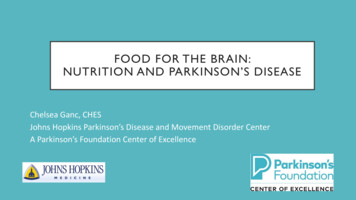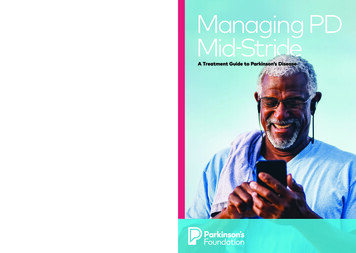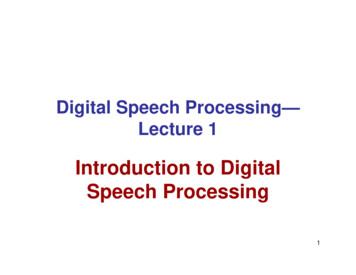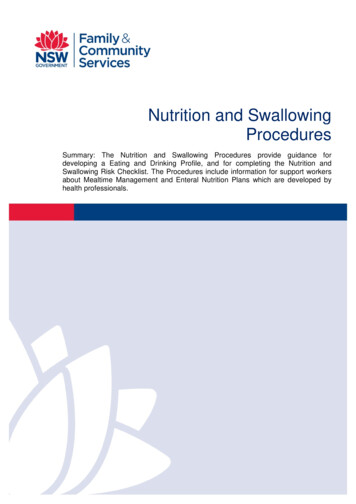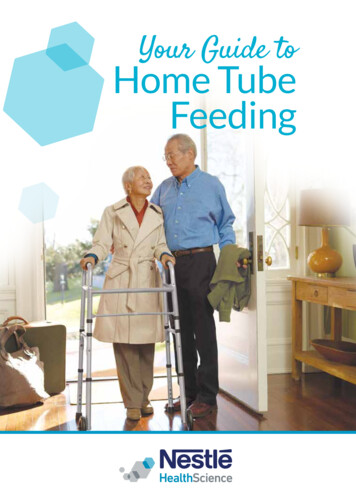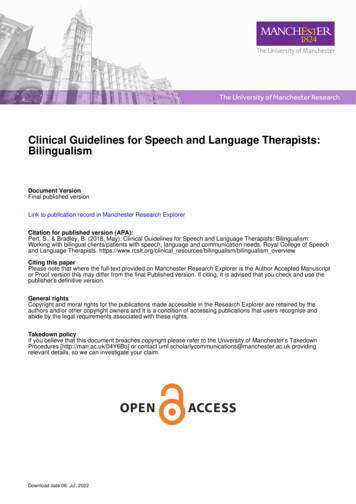
Transcription
Speech andSwallowingA Body Guide to Parkinson’s Disease
About this bookGlossaryDefinitions for all words underlined in blue canbe found in the glossary starting on page 46.A comprehensive Parkinson’s disease glossarycan be found at Parkinson.org/Glossary.IndexAn index of key words and topics can be foundon page 48.parkinson’s foundation resourcesCertain pages include tip sheets with practicalpointers. You can find more helpful tips for managingParkinson’s-related speech and swallowing changesin the books, fact sheets, videos, webinars andpodcasts in our PD library at Parkinson.org/Library.
1Most people with Parkinson’s disease (PD) will experiencechanges in speech, voice and swallowing at some pointduring the course of the disease. The same PD symptomsthat occur in the muscles of the body – tremor, stiffnessand slow movement – can occur in the muscles used whenspeaking and swallowing.Changes in language and cognition include: thinking skills, how quickly youprocess information (i.e., speed of processing), focus/attention, findingwords, memory and problem solving can also affect communication. Changesassociated with Parkinson’s disease may also affect the ability to expressand understand voice pitch changes (i.e., prosody) and facial expressions thatconvey emotion (e.g., happiness, sadness, humor).Like other symptoms of PD, difficulties with speech and swallowing will varyfrom one person to another. This book will provide you with information,tools and exercises to help you better understand and manage speech,swallowing, voice, communication and cognitive problems in PD. However, itis important that people with PD and their family members advocate for areferral to a speech-language pathologist. This book is not intended to replacea consultation with a speech-language pathologist or other allied healthspecialist, but can help you to advocate for yourself or a family member byincreasing your awareness of how a speech-language pathologist can help you.
2ContentsAboutParkinson’sDisease5Speech,Voice andCommunicationChallenges7Memory andThinkingChanges in PD29Anatomyof SpeechProduction andSwallowing33
3SwallowingChanges15Gettingthe HelpYou Need20Appendices 39Glossary 45Index 48Summary38
AcknowledgementsThis book was written and reviewed by:Angela Roberts MA-SLP, PhD, CASLPO-Reg./SLPAssistant Professor, Roxelyn and Richard Pepper Department ofCommunication Sciences and Disorders, Northwestern UniversityEvanston, Illinois, USA and Adjunct Research Professor, CommunicationSciences and Disorders, Western University, London, Ontario, CanadaMarjorie L. Johnson, MA/CCC-SLPThis book has been made possible through thegenerous donations of thousands of individualsaffected by Parkinson’s.Design: Ultravirgo
5chapter oneAbout Parkinson’sDiseaseIf you’re reading this book, you are probably alreadyfamiliar with Parkinson’s disease, but here are some basics:Parkinson’s is a progressive, neurodegenerative disorderthat affects about one million people in the United Statesand 10 million people worldwide. It is called a movementdisorder because of the tremors, slowing and stiffeningmovements it can cause, but its symptoms are diverse andusually develop slowly over time.Parkinson’s disease is not diagnosed with a test or a scan; instead it isdiagnosed by your doctor, who asks you questions about your health andmedical history and observes your movement. Your doctor may want you tohave some tests or imaging. An MRI (magnetic resonance imaging) can helprule out other conditions, and a DaTScan can help confirm a Parkinson’sdiagnosis, if there is uncertainty. The goal of treatment is to help youmanage your symptoms. Good symptom management can help you to stayhealthy, maximize your quality of life and keep active. Although there is noway now to correct the brain changes that cause Parkinson’s, we know thatexercise can help you fight the disease and that staying healthy can preventsetbacks that make PD progress faster. Great care is the key to living yourbest life with Parkinson’s.
6speech AND swallowingLack of dopamine in people with Parkinson’s was first described in the1960s. Dopamine is a neurotransmitter, one of several chemicals your braincells use to send signals to one another. Soon after, dopamine-replacementtherapy using levodopa became – and remains – the gold standardtreatment. However, just as your doctor looks at tremors as a sign ofchanges in your brain, neuroscientists know that the reduction in dopaminein the brain is a sign of changes occurring in brain cells. Neuroscientiststhink of Parkinson’s as a disease linked to several things in brain cells, frommitochondria, the power plants of the cell, to lysosomes and proteasomes,the garbage disposals of the cell. You might also hear that Parkinson’s islinked to a protein in the human brain called alpha-synuclein. The exact waythat all these pieces fit together remains unknown. Researchers continue tostudy how cells and brain networks are affected in Parkinson’s to improveour understanding of the disease and potential for treatments. We doknow that dopamine is not the only neurotransmitter to be affected byParkinson’s. The disease process also disrupts other brain chemicals likeserotonin, norepinephrine, and acetylcholine. Changes in these chemicalscan affect mood, behavior and thinking (cognition).Your family may have questions or fears about Parkinson’s and genetics.While there are several genetic mutations that can increase your risk, forthe vast majority of people, Parkinson’s is not inherited. There is no testthat can accurately predict who will develop Parkinson’s. Extensive geneand biomarker research is underway to uncover the possible precursors –not necessarily causes – to disease development.
7chapter twoSpeech,Voice andCommunicationChallengesAbout 75 percent of people with PD experience changesin speech and voice at some time during the course of thedisease. These changes usually come on gradually and canvary from mild to severe.Communication is a vital part of daily life and extends beyond speechand voice abilities. It also includes the ability to formulate your ideas intoa message; understand messages and words conveyed by others; andthe ability to put your ideas into words. Communication also includesthe ability to use body language, gestures and voice pitch/loudnesschanges to emphasize ideas, add humor and convey emotions. Problemscommunicating can lead to feelings of frustration, depression andwithdrawal. Learning how PD affects communication and what you can doabout it can help you better cope with problems that you might experience.Many of these problem areas can be improved with PD-specific exerciseprograms, devices that help communication and strategies/techniquesthat can help you and your conversation partners to communicate moreeffectively and efficiently.
8speech AND swallowingWhat Can I Do to Improve My Speechand Communication?In addition to seeing a speech-language pathologist, there are somestrategies that you, your family and your friends can use to improvecommunication.Take Care of Your VoiceIt is important to take care of your voice. Here are some simple suggestionsfor good “voice hygiene.” Drink plenty of water or other liquids each day(non-caffeine and non-alcoholic). Do not strain your voice by shouting over loud noise when you talk. Rest your voice when it is tired. Like other muscles in your body, themuscles controlling your speech need a break sometimes. Reduce throat clearing or coughing. Use a hard swallow or softsound instead. If you have frequent heartburn or a gastroesophageal refluxdisorder, talk to your physician about ways to reduce and/oreliminate these symptoms. Some medications can also affect your voice quality. While most PDmedications do not negatively affect your voice, some medicationsused for other symptoms (e.g., antidepressants, allergy medicines, highblood pressure medications) can affect your voice. If you are taking oneof these medications, maintaining good ‘voice hygiene’ becomes evenmore important. If the air is dry in your home, consider using a humidifier.
Speech, Voice and Communication Challenges9PosturePosture is important for voice and speech. Keeping an upright posture and astraight neck (and slightly lifted chin) helps you to move air from your lungsthrough your vocal cords, which then vibrate to produce the sound wavesthat make your voice. These vibrations and sound waves are shaped by thejaw, lips, nasal cavity, teeth, and tongue to produce speech sounds. Havinggood posture is important for creating airflow to these structures. However,the motor changes associated with PD (and aging) can make it more difficult to maintain ideal voice and speech posture. Physical exercise, stretching,and yoga can help you to have better posture. Focusing on good posture,especially during moments where voice loudness is important, is also helpful.Try this Posture and Breathing ExerciseClear and understandable speech consists of sitting up as straight aspossible, taking a deep abdominal breath, exhaling with good energy,closing and vibrating the vocal folds, opening the mouth widely and usingprecise tongue and lip movements for articulation. Try the following stepsfor practice:1. Sit up straight.2. Take a deep breath and feel your stomach area expand as you fillyour lungs.3. As you begin to exhale, start your voice on a loud and clear “ah.”Think of your “ah” as coming from your breathing and being thrownacross to the other side of the room in an arc.4. Continue taking deep breaths and start your voice as you exhale.Give each word a new breath as you say any of the following: Days of the week Months of the year Numbers 1–20 Letters of the alphabetRemember to use plenty of breathing energy to power your voice and toexaggerate your tongue and lip movements. Do not strain to push yourvoice from your throat area.
10 speech AND swallowingRemember a Good Conversation Takes Two (or More) PartnersConversation, the mechanism we use to exchange messages with othersand to build/maintain relationships, is critical. Social engagement andmaintaining social ties are important for both emotional and cognitive health.Remembering that an effective and efficient conversation takes at least twopeople is important. While there are steps that the person with PD can take, itis important that conversation partners also improve their skills for listening,sending clear messages and looking for signals of conversation breakdowns. Minimize distractions and focus on your conversation partner. Choose to have important or more challenging conversations when theperson with PD and their conversation partner are well-rested and at their‘best’ time of day. Learn to look for signals that your conversation partner is having difficultyfollowing or understanding what you said. These signals can include: requestsfor repetition or responding with ‘huh’ or ‘I didn’t get that’. However, thesesignals can also be as subtle as a quizzical facial expression, failure to respondat all or appropriately, fidgeting, looking distracted or gradually withdrawingfrom the conversation. Make sure you send clear signals when you need helpor when you need a message clarified by your conversation partner. Provide help when needed. Use a calm and reassuring approach. Repeat orrephrase what you said (without elevating your voice loudness or excessivelyslowing your speech rate). For those with more severe cognitive impairments, you may want to usemultimodal cues such as pictures, gestures or words to get your meaningacross or to clarify your message in multiple ways. Resist blaming your conversation partner (or yourself) when a conversationbreakdown occurs. Conversations break down becausethe interaction between two (or more) people went wrong. Work to find thesource of the misunderstanding (e.g., a word not understood, changing topicswithout ample warning). When found, repair the breakdown (i.e., resolve anymisunderstandings) and get the conversation back on track. Resist the urge to give up or walk away from a conversation. When possible,try to clarify the misunderstanding and keep the conversation going.However, sometimes taking a break from the conversation does help. Comingback to a topic or a conversation at a later time can be useful, especiallywhen partners become frustrated.
Speech, Voice and Communication Challenges 11 Verify that you understood the message correctly. Restate, rephrase orask a direct question for clarification if you are unsure that your messagewas understood or whether you understood your partner’s message beforemoving on in the conversation. (e.g., Are you enjoying this show?”; “Did yousay you wanted to go to the movies tonight?”). Be patient with your conversation partner. Be empathetic in the context ofdifficult communication moments. Remember that conversations are also about bonding and maintainingrelationships. The words and speech sounds do not always have to be‘perfect’ for there to be an emotional connection about the topic. Minimizeattempts to correct words or speech sounds and instead focus on the intent,the general message and the emotions being expressed.Facial ExercisesMany individuals with PD request face and mouth exercises to reduce theeffects of rigidity of muscles in the face and to increase facial expression.Some people with PD may find exercises helpful. Try the exercises below.Start with 10 repetitions of each of the facial movements explained below. Eachexercise should be completed with purposeful movements and sustained effort.For instance, if smiling is the exercise, try to smile as wide as you can, and holdeach smile for 5–10 seconds. Make sure you continue to breathe throughout theexercises. Try practicing in front of a mirror, so you can see your muscles work.1. Smile – hold – relax – repeat.2. Pucker your lips – hold – relax – repeat.3. Alternate puckering and smiling.Pucker as tightly and smile as hard as you can. To increase the benefit ofthis exercise, knit your eyebrows together when you pucker, and raise thebrows when you smile.4. Open your mouth and move the tip of your tongue all around the lips.The tongue should touch every part of the lips: bottom, top and bothcorners. Movements should be deliberate, not darting.5. Open your mouth and move the tongue around the gumline.Move your tongue over the back of top and bottom teeth, front of topand bottom teeth and edges of top and bottom teeth.6. Open your mouth as wide as you can – hold – relax – repeat.7. Say KA – a prolonged sound – as loud and hard as you can.8. Say PA-TA-KA as loud and fast as you can.
12 speech AND swallowingMonitor Your Hearing HealthHearing loss is the third most common health problem in the United States.It is more common in people over the age of 60. While PD does not causehearing loss, recent studies suggests that people with PD may be at higherrisk for hearing loss. Hearing loss negatively affects communication whetherit occurs in the person with PD or their conversation partners. People areoften unaware of how severe their hearing loss is. Signs of hearing loss mayinclude turning up the radio or TV, more difficulty understanding speechin restaurants or noisy situations, difficulty understanding others over thetelephone and asking others to repeat themselves. If you suspect that youhave hearing loss, contact your physician or local audiologist for a hearingassessment and treatment options.Keep TalkingThe best way to practice talking is to talk! Do not limit your speakingbecause you feel self-conscious or have difficulty. The saying “use it or loseit” applies to speech, too. Here is a list of possible conversation topics.If you don’t have a companion to talk to, talk out loud to yourself! Talk about your family: who is related to whom, where everyone is from, etc. Describe a favorite hobby or pastime in detail. Give a report about a trip or vacation you enjoyed. Discuss a period of time or particular event you recall from childhood. Describe your favorite food or restaurant. Give your opinion and thoughts about a favorite topic. Talk about things you hope to accomplish in the next year. Acknowledge people by sharing what it is you most appreciate about them.Singing and VoiceSinging is a great exercise for the voice! Singing uses the same musclesthat are used for speech. Try taking a deep breath and singing yourfavorite songs. Gently reach for the high and low notes and sing the lyricsas clearly as you can. This is not only great exercise – it can help you feelgood emotionally, too. If you are a singer, you may notice that your vocalrange changes with PD. Be careful not to strain or force your voice beyondwhat is comfortable and to use your good ‘voice hygiene’ tips. You shouldnot feel any pain when singing or speaking. If you do feel pain, it may bea sign that you are straining your voice or may indicate a more seriouscondition. If pain occurs when singing or speaking, discuss these symptomswith your doctor.See Chapter 6 for details about the anatomy of speech production.
Speech, Voice and Communication Challenges 13Tips for Family and FriendsFamily and friends are often the best support system for people with PD.There are several things you can do to help your loved one communicatemore effectively.The first and most important thing is to encourage your family memberor friend to consider speech therapy when changes in communicationare noticed. A speech-language pathologist can develop a programtailored to the person with PD’s needs. The following tips and strategiesare also helpful: Get face-to-face when talking. Try to maintain a distance of no morethan 3-6 feet. Minimize having conversations between rooms or acrosslong distances. Make sure that the lighting in the room is optimized sothat you can see your partner’s face and mouth movements clearly.Words, facial expressions and gestures are easier to understand whenyou can see and hear them being produced. Reduce background noise. Turn off the radio and TV, close car windowsand shut doors to noisy areas. Be aware that people with PD may not accurately express theiremotions through facial expressions because of rigid facial muscles.This can be complicated by their quieter voices and sometimes difficultto understand words. Instead of assuming that your family member/friend does not understand your message or that you understood theirscorrectly, check in and verify that the message was understood correctly. Be patient. Allow ample time for the person with PD to communicate.Don’t rush or force responses. When necessary, ‘make room’ in the conversation for the person withPD by opening the conversation for their turn or slowing down the paceof conversation. For example, “Tom and I were just talking about thisyesterday and he had some great ideas. Tom I’m sure Sarah would loveto hear your thoughts.” Preserve dignity and personhood. Minimize talking ‘for’ the person withPD or filling in their responses unless they ask you to do so or you haveasked (and received) their permission to respond for them.
14 speech AND swallowing In cases where cognitive decline is more severe:– Use shorter sentences with one idea per sentence when communicatingwith the person who has PD.– Use common vocabulary and words that are familiar to the person.– Ask questions that can be answered in a short sentence or with a “yes”or “no” response.– Alternatively, ask questions and then provide two or three options tohelp to help the person make their choice clear (e.g. Do you want juice?Apple or orange?)– Use multimodal supports including writing down key words/shortphrases that capture what you are trying to communicate, picturesand gestures to help reinforce the message you are conveying. Thesemultimodal supports can also help provide a way for the personwith PD to respond by pointing to a picture or to a word printedon a page. Provide messages in a number of different ways to helpenhance understanding.– Provide shorter chunks of information and allow extra time to processinformation. Resist slowing down your speech in an exaggerated wayor overexaggerating your speech production – in some cases this canworsen communication.– Stay calm. Do not raise the loudness of your voice in an exaggeratedway when repeating or rephrasing information. This can be emotionallyupsetting for the person with cognitive impairment.
15chapter threeSwallowingChangesPeople with PD may notice changes or difficulty withchewing, eating or swallowing. These changes can happenat any time, but they tend to increase as PD progresses.While there are some common signs of difficulty swallowing, it isimportant to remember that people with PD may not always show (or beaware of) these signs. For example, PD can negatively affect the coughresponse, a natural reflex that protects the airway during eating, drinkingor swallowing saliva. For this reason, people with PD may not alwaysdemonstrate coughing during meals even though they have problemswith swallowing.Assessment by a speech-language pathologist, which may include anX-ray of your swallowing (i.e., a modified barium swallow study, also calleda videofluoroscopic swallow study), or a fiberoptic endoscopic exam ofyour swallowing (i.e., direct examination of your throat during swallowingusing a flexible tube with a camera on the end), is important for assessingswallowing problems in PD.
16 speech AND swallowingCommon symptoms of swallowing problems include the following: Slowness in eating. A sensation that food is caught in the throat. Coughing, throat clearing or choking while eating or drinking. Difficulty swallowing pills and drooling. Food sticking in the mouth or difficulty chewing. A sensation that swallowing takes effort and a feeling of fatiguewhen eating.How Can I Manage My Swallowing Problems?People with PD can have a variety of different problems swallowing thatrange from mild to severe. The techniques and strategies for improvingyour swallowing are best developed with a medical team that includes aspeech-language pathologist and may also include a registered dietitian.Some problems with swallowing may require you to change the textureof your food and possibly the thickness of the liquids you consume. Otherproblems may require you to learn to swallow in a different way using aswallowing strategy. Your speech-language pathologist can develop acustomized strategy, diet modification and exercise program for you.When it comes to swallowing problems, there is no ‘one-size-fits-all’approach. The same strategies that may be helpful for one person maynot work (or may create more difficulties swallowing) for another. Thefollowing are general tips and techniques that can help improve youreating, chewing and swallowing.Sitting upright in firmlysupporting chairGood view of food on tableHands on table if possiblePillows for support atlumbar areaHips and knees flexed at 90 degreesFoot placed comfortably on floor(use footstool to position for correctheight if necessary)
Swallowing Changes 17 Always sit upright (preferably in a chair) when eating, drinking andtaking pills. If you are able, sit upright for 30–60 minutes after eating. Chew small amounts of food well and swallow it all before eating more. Put your fork down between bites to slow yourself down. If food feels stuck, swallow multiple times (at least twice) afterevery bite. Take small sips when drinking. Take one sip at a time. Do not gulp or tipyour head backward when drinking. Be wary of straws. Straws are useful when someone has severe tremorsor dyskinesias but can put too much liquid, too far back into the mouth,too quickly before the airway has a chance to close. Try to keep the strawonly at the front of your tongue. Keep your chin slightly down or at least parallel to the table. There issometimes a tendency to lift the chin when drinking the last little bit ofliquid in a cup or bottle. When the chin is raised, there is an increased riskof getting fluid in the lungs. Be cautious when drinking from cans, soda/pop bottles, and water bottles. Consider using a cup or water bottlewith a lid or removable cap, instead of those with valve-type nozzles(e.g., push/pull valves, spouts). Don’t talk with food in your mouth. Minimize distractions during meals. Distractions may cause you tobe less aware of your chewing and swallowing and may increase therisk of choking.
18 speech AND swallowing Consider eating several small meals during the day. This may helpreduce fatigue during eating that occurs because of difficultyswallowing or difficulty feeding yourself. Be aware of food sticking in your mouth. Use your tongue to help clearfood. Make sure that your mouth is clear of all food before takingadditional bites. If you have difficulty chewing or clearing food from your mouth, choosesoft, moist foods (e.g., lasagna, pureed soups). Avoid, dry or crumblyfoods that fall apart easily. Use caution when eating foods with botha liquid and solid component (e.g., fruit cocktail) and consider drainingoff the liquid portion.The types of foods you eat can affect chewing and swallowing. A speechlanguage pathologist or registered dietitian can recommend foods andbeverages that are easiest to swallow. An occupational therapist canrecommend various types of helpful tools that can make eating a morepleasant experience.You can also consult our online resources for Caregivers, including twovideos on Mealtime and Swallowing, at Parkinson.org/Mealtime.What Can I Do About Drooling?If you tend to drool, you probably don’t have more saliva than you used tohave; you are just not swallowing it as frequently or as automatically asbefore. Frequent sips of water or sucking on ice chips during the day canhelp you swallow more often. When you are not talking or eating, keepyour head up, with your chin parallel to the floor and your lips closed.Sugar tends to produce more saliva in the mouth, so reducing sugarintake can be helpful.One trick is to suck on hard candy or chew gum, preferably sugarless.Candy and gum activate the jaw and the automatic swallowing reflexand can help clear saliva, providing temporary relief from drooling.Another tactic is to wear a sweatband on your wrist. This can beused to discreetly wipe the mouth as necessary and is a relativelyinconspicuous accessory.
Swallowing Changes 19If these lifestyle strategies are not effective, adjusting anti-PD medicationsmay make it easier to swallow. There are also some other prescriptionmedication options:Glycopyrrolate and other oral anticholinergic medications(trihexyphenidyl, benztropine, hycosamine): Oral anticholinergicmedications, as a class, decrease the production of saliva. Usually this isperceived as a side effect (dry mouth), but in this case it is an advantage.Other anticholinergic side effects may be seen, including drowsiness,confusion, vomiting, dizziness, blurred vision, constipation, flushing,headache and urinary retention. Anticholinergics can also have mentalside effects, so their use should be carefully considered.Scopolamine transdermal patch: This patch offers anticholinergicmedicine that slows production of saliva as it is absorbed into the entirebloodstream. The side effects are similar to those seen with useof oral anticholinergic medications.1% atropine eye drops (an anticholinergic): This treatment is given as1–2 drops under the tongue per day to dry the mouth. Systemic sideeffects are much less likely with this local treatment.Botulinum toxin A: Botulinum toxin weakens muscles. Botulinum toxinA (Botox) is sometimes used to decrease saliva production for peoplewho have issues with drooling; botulinum toxin B (Myobloc) is used totreat dystonia. Injection of botulinum toxin A into the salivary glandsof the cheek and jaw can decrease production of saliva without (or withminimal) side effects, except for thickening of oral mucus secretion.Botox is not always effective, but when it works the benefit can lastfor several months before it wears off and re-injection is necessary.Botulinum toxin A can be an effective treatment for severe droolingbut is more costly than other treatments, which your physician maywant to try first. Botulinum toxin should probably be avoided when oralsecretions are already very thick and difficult to clear. Botulinum toxin Bcauses dry mouth when used for dystonia, but it is not approved by theFDA for drooling.Many people with PD complain that they have a thick phlegm or mucusin the throat. Drinking more water will help thin this phlegm. Drinkingcarbonated beverages or tea with lemon may also help. Eating or drinkingdairy products can make phlegm worse.See Chapter 6 for details about the anatomy of swallowing.
20chapter FOURGetting theHelp You NeedEarly intervention with a Speech-Language Pathologistis key to maintaining and improving communication andswallow function. It is easier to learn strategies andtechniques than it is to rebuild what has already beenlost. Still, it is never too late to get help for speech andswallowing. Improvements following therapy at whateverstage of PD are often surprising and rewarding.What Is a Speech-Language Pathologist?Speech-language pathologists are licensed healthcare professionals trainedto evaluate and treat people with speech, voice, language, thinking skills,memory and swallowing problems. Many have completed additional trainingfor working with people who have PD. In the United States, a speechlanguage pathologist has a graduate degree and is certified by the TheAmerican Speech-Language-Hearing Association (ASHA). Speech-languagepathologists in the United States are licensed by the state where they work.You can find speech-language pathologists at local hospitals, rehabilitationcenters and at some university-based training clinics. They also provide
21services to individuals living in care centers and those living
and yoga can help you to have better posture. Focusing on good posture, especially during moments where voice loudness is important, is also helpful. Try this Posture and Breathing Exercise Clear and understandable speech consists of sitting up as straight as possible, taking a deep abdominal breath, exhaling with good energy,


